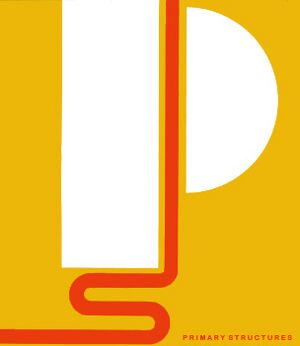Primary Structures (1966 exhibition) facts for kids
Primary Structures: Younger American and British Sculptors was a special art show. It happened at the Jewish Museum in New York City. The show ran from April 27 to June 12, 1966.
This exhibition displayed new sculptures by artists from the United States and Great Britain. These artworks had some things in common. They were often large, had simple geometric shapes, and smooth, colorful surfaces. Many were made from industrial materials.
Primary Structures is famous because it introduced a style of art called Minimal Art to many people. The show itself and the attention it got in the news helped make this art style well-known. Kynaston McShine, who was the Jewish Museum's Curator of Painting and Sculpture, organized the exhibition.
Contents
What is Minimal Art?
Minimal Art is a style where artists use very simple shapes and colors. They often use industrial materials like metal or plastic. The idea is to focus on the basic form of the artwork. These artists wanted the art to be just what you see, without hidden meanings. They often used repeated shapes or lines.
Artists and Their Works
The "Primary Structures" exhibition featured many artists. Their sculptures were placed in different areas of the museum. Here's a look at some of the artists and their works that were part of this important show:
Sculpture Court/Entry
This was the first area visitors saw.
- David Annesley, Swing Low, 1964
- Anthony Caro, Titan, 1964
- Tony Smith, Free Ride, 1962
Lobby
Right after the entrance, more sculptures were displayed.
- Judy Cohen Gerowitz (Judy Chicago), Rainbow Picket, 1966
- Robert Smithson, Cryosphere, 1966
Gallery 1
This gallery held several unique pieces.
- Dan Flavin, corner monument 4 for those who have been killed in ambush (for Jewish Museum) (for *P.K. who reminded me about death), 1964
- Peter Forakis, JFK, 1963
- Ellsworth Kelly, Blue Disc, 1963
- Forrest Myers, Zygarat & W. & W.W.W., 1965
- Salvatore Romano, Zeno II, 1965
- William Tucker, Meru I, 1964
- William Tucker, Meru II, 1964
- William Tucker, Meru III, 1964–65
- David von Schlegell, Wave, 1964
Underpass
Some art was even placed in the museum's underpass area.
- Gerald Laing, Indenty, 1966
- Gerald Laing, Trace, 1965
- Tina Matkovic (Spiro), Projection, 1965
Gallery 2
More sculptures were found in Gallery 2.
- Carl Andre, Lever, 1966
- Lyman Kipp, Andy's Cart Blanche
- Tim Scott, Peach Wheels, 1962
- Richard Van Buren, Free Epton, 1966
- Isaac Witkin, Nagas, 1964
Gallery 3
This gallery featured two artists.
- Tony DeLap, Ka, 1965
- Tom Doyle, Over Owl's Creek, 1966
Gallery 4
Gallery 4 had a diverse collection of works.
- Richard Artschwager, Table with Pink Tablecloth, 1964
- Richard Artschwager, Rocker, 1965–75
- Michael Bolus, No. 7, 1965
- Paul Frazier, Pink Split, 1965
- Douglas Huebler, Bradford 2-66, 1966
- John McCracken, Northumberland, 1965
- Peter Phillips, Tricurvular, 1964–65
- Anne Truitt, Sea Garden, 1964
Gallery 5
This gallery showcased some very well-known Minimal artists.
- Ronald Bladen, Three Elements, 1965
- Robert Grosvenor, Transoxiana, 1965
- Donald Judd, Untitled, floor 1966
- Donald Judd, Untitled, wall 1966
- Robert Morris, Untitled (L Beams), 1966-67
Gallery 8
More abstract and minimal pieces were in Gallery 8.
- Larry Bell, Untitled(peach)
- Larry Bell, Untitled(pink)
- Larry Bell, Untitled(gold)
- Walter de Maria, Cage, 1961-65
- Sol LeWitt, Untitled, 1966
Gallery 10
The final gallery presented more sculptures.
- Daniel Gorski, Fourth Down
- David Gray, LA/2, 1965
- David Hall, Izzard, 1966
- Phillip King, Through, 1966
- John McCracken, Manchu, 1965
- Peter Pinchbeck, Space Jump
- Michael Todd, Viet, 1966
- Michael Todd, Ball Joint, 1966
- Derrick Woodham, Siviley, 1965


